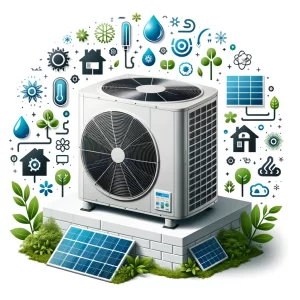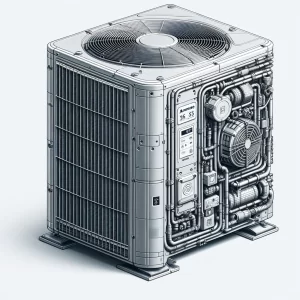
The video explains the key components and processes involved in the refrigeration cycle.
Overview of Refrigeration Cycle
The refrigeration cycle is a fundamental process that enables refrigeration systems to cool enclosed spaces or substances by extracting heat from them. This cycle involves specific components and phases that work together to achieve the desired cooling effect.
- High Pressure and Low Pressure Sides Separated by Compressor: One of the key aspects of the refrigeration cycle is the clear distinction between the high pressure side and the low pressure side, which are separated by the compressor. This separation is crucial in maintaining the efficiency and functionality of the system.
- Compressor Increases Pressure and Temperature: The compressor plays a vital role in the refrigeration cycle by increasing the pressure and temperature of the refrigerant vapor. This process is essential for the refrigerant to release heat efficiently and facilitate the cooling process.
- Metering Device Lowers Pressure and Temperature: Following the compression stage, the refrigerant passes through a metering device that lowers its pressure and temperature. By reducing the pressure, the refrigerant can absorb heat effectively at the evaporator and maintain the cooling cycle.
Understanding the dynamics of the refrigeration cycle and the functions of each component is essential for ensuring the optimal performance of refrigeration systems. Proper maintenance and regular inspections can help identify any issues and prevent potential breakdowns, ultimately extending the lifespan of the system.
By grasping the intricacies of the refrigeration cycle, individuals can optimize the cooling efficiency of their systems and promote energy savings in various applications, from household refrigerators to industrial cooling units.
Heat Absorption and Rejection
The refrigeration cycle involves a complex process vital for the functionality of various cooling systems. It consists of high pressure and low pressure sides distinguished by the compressor and metering device. The compressor plays a pivotal role in elevating both pressure and temperature levels within the system, whereas the metering device works to reduce pressure and temperature.
One of the key aspects of the refrigeration cycle is the absorption and rejection of heat. This critical function is carried out by the refrigerant at two key points within the system – the evaporator and the condenser.
At the evaporator, the refrigerant absorbs heat from its surroundings, facilitating the cooling process. This absorption of heat is essential for the refrigerant to transition into a low-pressure vapor state, allowing it to carry out its cooling function efficiently.
Conversely, at the condenser, the refrigerant releases the previously absorbed heat. This heat rejection process is crucial for maintaining the desired cooling effect within the system. The condenser coil serves as the platform where the high pressure vapor refrigerant enters to discharge the accumulated heat. As a result, the refrigerant exits the condenser as high pressure liquid refrigerant, ready to continue its journey through the system.
In order to effectively release the heat within the condenser coil, the refrigerant must undergo a transformation from high pressure vapor to liquid form. This transition is essential for the refrigerant to transfer its heat energy efficiently, enabling the cooling system to operate at optimal levels.
Throughout the refrigeration cycle, the refrigerant undergoes various stages of transformation to fulfill its role in cooling. After exiting the condenser as high pressure liquid refrigerant, it proceeds to travel through the system. During this journey, the filter dryer plays a crucial role in extracting moisture from the refrigerant to safeguard the compressor from potential damage.
Subsequently, the refrigerant proceeds to the metering device, where its pressure is lowered to allow for expansion and absorption of heat energy at the evaporator coil. This process sets the stage for the refrigerant to repeat the cycle, with the low pressure vapor refrigerant returning to the compressor for further processing.
It is imperative to ensure that only vapor refrigerant enters the compressor to prevent any detrimental effects on its functionality. By maintaining this key principle, the refrigeration cycle can operate smoothly, ensuring an efficient cooling process.
For individuals seeking to deepen their understanding of refrigeration systems, a plethora of educational resources and study materials are readily available. These include books on refrigerant charging and service procedures, comprehensive workbooks with a multitude of practice questions, and quick reference cards detailing refrigerant weights and charge-checking methods.
By exploring these resources and delving into the intricacies of refrigeration systems, enthusiasts and professionals alike can enhance their knowledge and expertise in this fundamental area of cooling technology.

System Components and Functions
In the realm of refrigeration systems, understanding the intricate dance of system components and their functions is paramount. One such crucial element is the movement of sub-cooled liquid through the system, a process that plays a pivotal role in the overall operation.
As the video elucidates, the sub-cooled liquid embarks on a journey through the system, traversing various components to fulfill its designated tasks. One key player in this process is the filter dryer, an unsung hero that works diligently to rid the liquid of moisture, thereby safeguarding the integrity of the compressor.
Moreover, the metering device emerges as a crucial cog in the system, facilitating the expansion and absorption of heat energy. This component allows for the transformation of the refrigerant, enabling it to perform its heat exchange duties efficiently.
- Sub-cooled Liquid Travels Through System: The sub-cooled liquid’s passage through the system is not merely a mundane journey; it is a vital step in the refrigeration cycle. This phase sets the stage for subsequent processes, laying the foundation for effective heat exchange.
- Filter Dryer Removes Moisture to Protect Compressor: The significance of the filter dryer cannot be overstated. By extracting moisture from the liquid, this component shields the compressor from potential harm, ensuring its smooth operation and longevity.
- Metering Device Allows for Expansion and Absorption of Heat Energy: The metering device stands as a linchpin in the system, orchestrating the expansion and absorption of heat energy with finesse. By regulating the flow of refrigerant, it optimizes the heat exchange process for maximum efficiency.
In essence, each component in the refrigeration system plays a distinct role, harmonizing with others to ensure the smooth operation of the entire mechanism. The synergy between the sub-cooled liquid, filter dryer, and metering device exemplifies the intricate dance of system components and functions in the realm of refrigeration.
Importance of Proper Refrigerant Handling
In the refrigeration cycle, the compressor plays a vital role in increasing pressure and temperature, while the metering device lowers pressure and temperature. This cycle involves high pressure vapor refrigerant entering the condenser coil to release heat and exiting as high pressure liquid refrigerant. The system then moves this sub-cooled liquid, ensuring it is free from moisture with the help of a filter dryer before entering the metering device for expansion and heat absorption at the evaporator coil.
It is imperative to safeguard the compressor from potential damage by ensuring only vapor refrigerant enters it. Understanding this process and the proper handling of refrigerants is essential in maintaining the efficiency and longevity of the refrigeration system.
For those seeking to delve deeper into the world of refrigerant handling and maintenance, various resources are available for further learning. These resources can be found on websites and online platforms like Amazon. They include an array of educational materials such as books on refrigerant charging, service procedures, comprehensive workbooks with practice questions, and quick reference cards detailing refrigerant weights and charge-checking methods.


